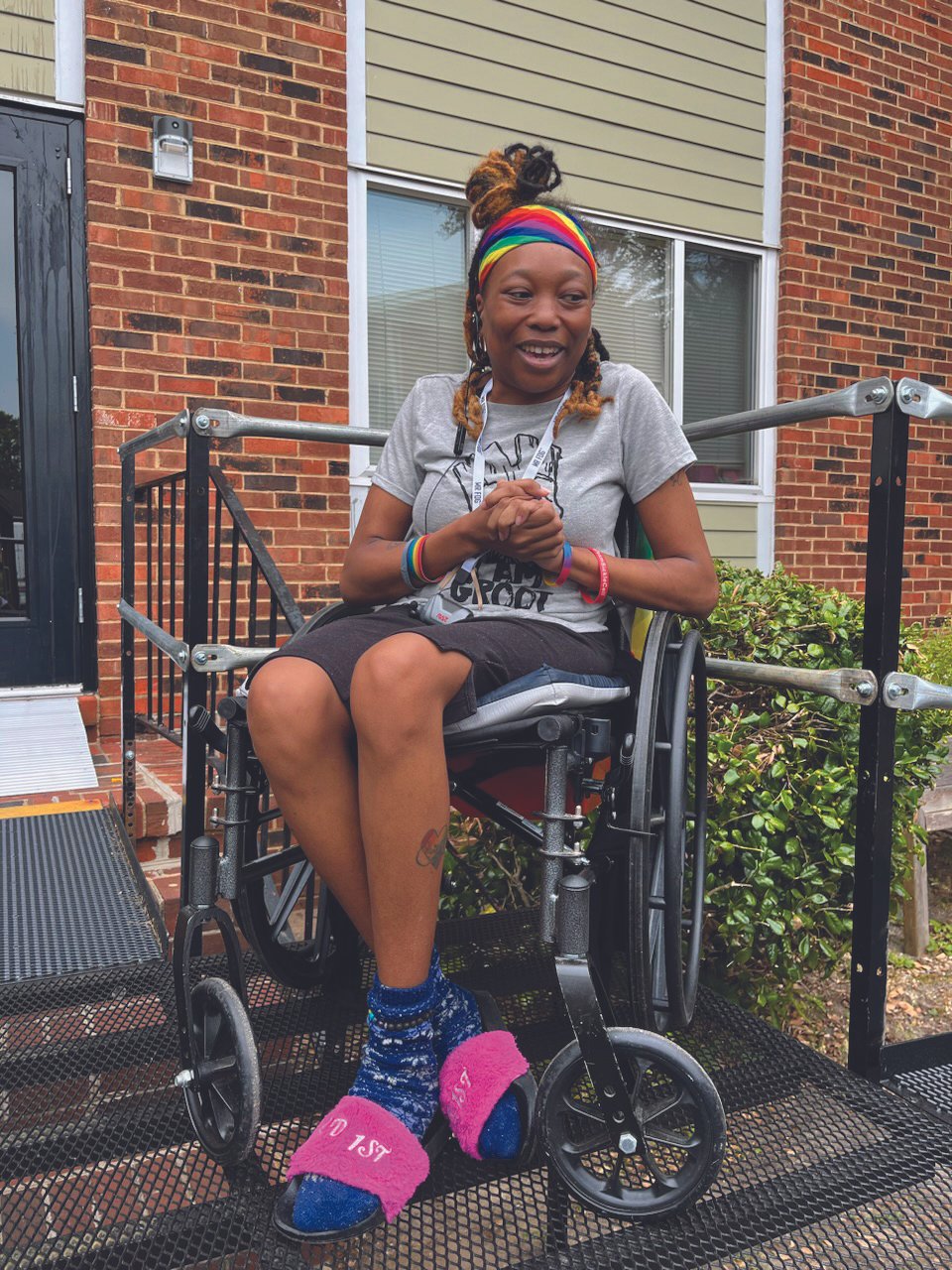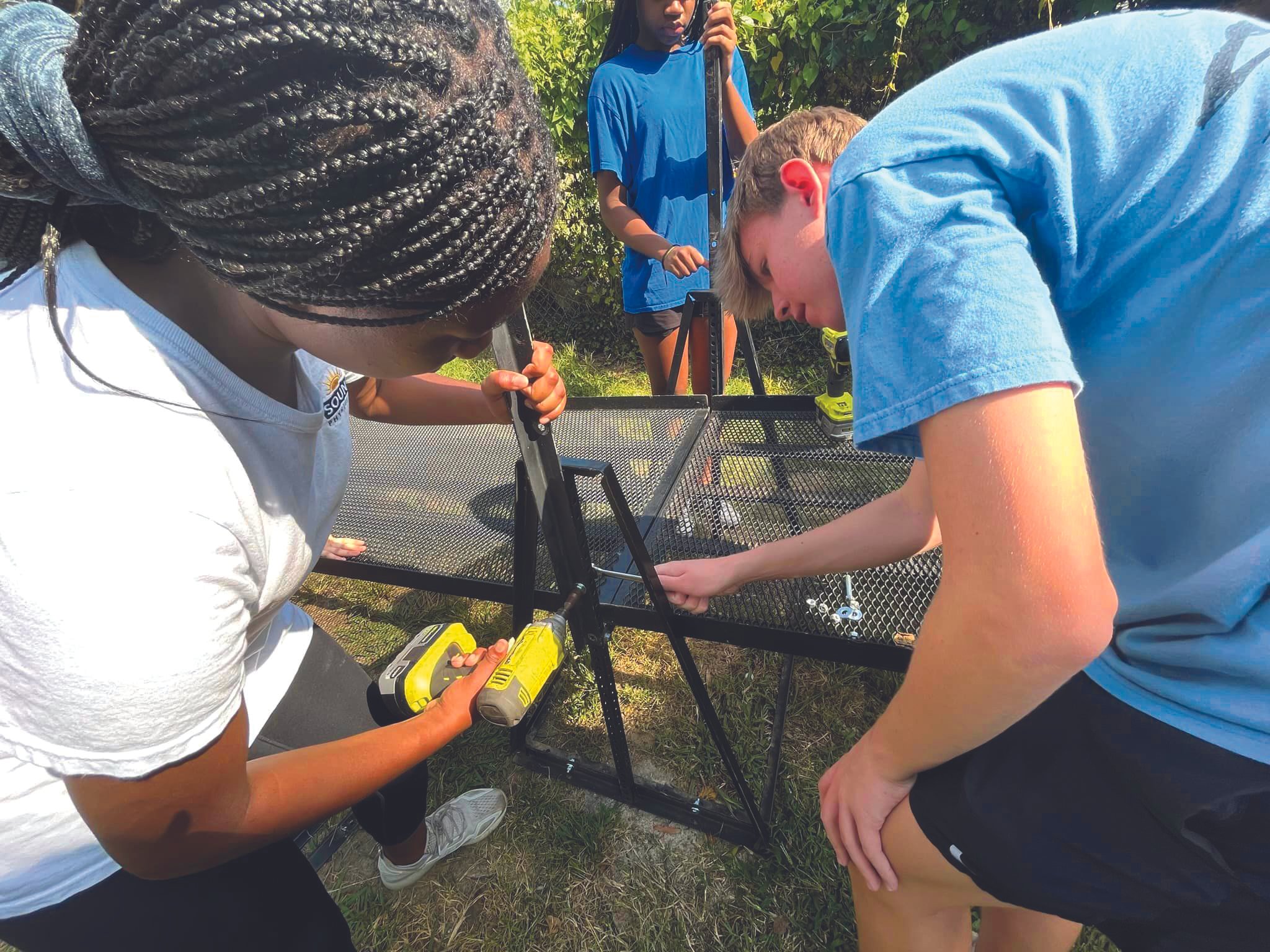Mr. H, who lives alone, is thrilled with his new ramp, built by staff and community volunteer Karen Roane.
RampsRVA: The Freedom Fighters
by Charles McGuigan 10.2023
Eagles, falcons and hawks can see far better than any human being, and moths can hear the flapping of a bat’s wings from fifty yards. In terms of speed on land and water, animals easily outmaneuver us— cheetahs top out overland at 70 miles an hour, and black marlins have been clocked at swimming 80 miles an hour. In the weight-lifting division dung beetles take the gold, easily pressing over 1,000 times their body weight. And the broad jump goes to the common flea that can leap 220 times its own length. Human beings do have some strengths unsurpassed in the animal kingdom, but only if those strengths are nurtured and encouraged: They are called compassion and empathy.
Way back in 2005 a group of Collegiate High School School students got together for a community service project. What they decided to do was build a couple of wheelchair ramps for folks who didn’t have the financial wherewithal to build their own. It was the birth of Ramps RVA which to date has installed more than 600 ramps for wheelchair users in Richmond, Henrico and Chesterfield.
It’s hard to believe in a country as wealthy as ours, with corporate CEOs making $70 million a year and bloated billionaires amassing unprecedented profits while the world suffered an international pandemic, that we still lack universal healthcare that would cover basic necessities like wheelchair ramps. If one of the nauseatingly wealthy decided to sell one of her $40 million yachts (just one of ten, mind you) she’d be able to purchase ten thousand wheelchair ramps. Just to maintain that one yacht for a full calendar year costs $4 million. But to the greed infected well-to-do cost is never an issue.
Tonya D. cries with joy over her newfound independence.
When Barry McDonald, director of operations for Ramps RVA, tells me the group’s annual budget is about $150,000, I’m not at all surprised. Their offices are modest, and housed in a nondescript strip mall in the far West End, literally a stone’s throw from the Goochland County line. About the only sign of their existence here is the signature RampsRVA truck parked out back.
Here’s something else that immediately struck me: both Barry and his right-hand woman, Anne Jones, absolutely love what they do for a living. They get their hands dirty, helping erect the ramps; love engaging with recipients and volunteers alike. During an interview the pair tell me a lot more about this organization that sprang from the wells of compassion and empathy, those admirable human traits that seem to come so easily to the young and the young at heart.
“When they first started, the group built a couple of wooden ramps, but they thought they weren’t sustainable,” says Barry. So these high school students began researching ramps.
“That’s when they found out there was this product out there called a modular ramp made of metal,” Barry says. “And they started using ramps from a company called Amramp.” These are the ramps still used by the organization and they’re American made, manufactured in Randolph, Massachusetts, with a franchise here in Richmond.
Ms. A, living with cancer and other serious medical issues, takes a test run with her son on her new ramp, built by Deep Run High School students.
“It’s a pretty interesting concept,” says Barry. “They are permanent ramps, but they’re modular. When I say permanent I really mean the recipient keeps it as long as it’s needed. Once it’s no longer needed, it’s recycled. The components are put back in our stock and we reuse them.”
Barry invites me to imagine an Erector Set. This child’s toy, which has been around for more than a century, features metal beams and rods with regularly spaced holes for easy assemblage with nuts and bolts. “It’s kind of like that,” he says. “Ramp sections are eight-foot, six-foot, four-foot, three-foot and eighteen inches. And so they fit together. All the holes line up on all the pieces. The same for the railings.”
“And then it’s all bolted together,” says Anne, who has assembled her fair share of ramps. Each ramp is carefully customized to meet the specific requirements of the recipient’s home. “The first thing we do is go to the home and have a little conversation with the owner,” Barry says. “We take pictures, we do measurements of the height of the stoop, and if it’s going to need a turn. We do some
measurements around that, and then send all that information to Amramp and then they do a CAD (computer-aided design), and they send that to us. And in that CAD basically it tells us every piece we need down to the last washer. It serves as a blueprint for the project.”
But before that project launches the receiver of the ramp has to meet certain criteria. “The process is we get a request and then Anne follows up with the person making the request,” says Barry. “The initial requirement is that they have to live in the service area (Chesterfield, Henrico or Richmond). They have to meet certain income requirements and we use HUD (Housing and Urban Development) as a guideline.”
Added bonus you get to use power tools.
“It’s the HUD low income guidelines, which for a two-person household is around $60,000,” Anne explains. But even with incomes substantially higher, the cost of one of these ramps would put an enormous strain on a family’s budget. “The average ramp costs about $4,000 and that’s a lot of money,” says Anne.
Putting the ramps together is a job undertaken by volunteers, and there seems to be no shortage of them. “We have eleven high school clubs but the only one we have in Richmond is Maggie Walker Governor’s School,” Barry says. “From a school perspective we need more of a presence in the city. Many of our recipients live in Richmond.”
At this juncture there are about 60 wheelchair users on RampsRVA’s waiting list for much-needed ramps. When I ask what can be done, Anne says, “Donate. We have volunteers, we need money.”
Some local companies also supply both volunteers and funding. “We do some corporate builds,” says Barry. “The one we did this weekend was with a company called Burns and McDonnell. They gave us a donation for two builds, and so they did one in July and then one this past week.”
Monacan HS students made the lives of Mr. and Mrs. P much safer.
There are other corporations that get involved. “Altria is building two before the end of the month,” Barry says. “And CarMax built a few earlier this year.”
Student volunteers not only help build the ramps, they are also instrumental in securing funds. “We had one student who actually went to a local automobile dealership and got a $6000 gift,” Barry remembers.
This is all tied to one of the underlining philosophies of the organization. “Part of that is helping students understand that nothing is free in this world, somebody’s paying for it,” says Barry. “So the students are responsible for raising a certain amount of money toward any ramp that they build.”
Anne tells me a story about a young woman with sickle cell anemia which caused her substantial paralysis. She was unable to get herself out of her apartment on her wheelchair because of the steps, and lived in constant fear of becoming trapped in her apartment in the event of a fire. “She was excited to just roll out of the house,” Anne recalls. And when she first saw the completed ramp, this young woman burst into tears.
A team effort between Henrico High School and Northern Henrico Rotary Club resulted in the 600th ramp for young JM, who has lived with a spinal injury since birth.
And then Anne tells me the story of a young man who had a spinal injury at birth that rendered both legs paralyzed. As he grew older, his mother was no longer able to carry him down the front steps of their home to set him down in his wheelchair. “And he been crawling up the steps and down the steps, pulling himself up with his arms,” Anne says. He actually helped build the ramp, securing the final bolt. “The thing that we always hear from people is that they were trapped in their houses,” says Anne Jones.
Barry McDonald nods. “Last weekend in Hechler Village the lady we built a ramp for had not been out of her house since March,” he says. “We’re gonna build ramps for as many folks that need them that we have the money for and the volunteer power for. If we have the dollars that come in we will build whatever we can build.”
Here’s a letter from one of the recipients of a ramp that expresses it all clear as mountain air. “Dear Team,” it reads. “I felt the need to formally thank you all for your extended kindness. Being handicap has been a great cha lenge for me, to enjoy the quality of life has been limited for me. I have never met a group of people that was as considerate and kind as you all. The simple things in life often get
taken for granted, but for me to sit day after day in this house has caused a lot of depression. Today that day ends for me. Thank you all so much for giving me the freedom to get out and live.”
If you want to become a real freedom fighter consider making a donation of time and money to RampsRVA by calling (804)282-3605, or visiting rampsrva.org






